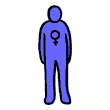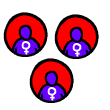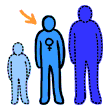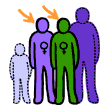Plural nouns are preceded by the plain articles tthu and kwthu, even when referring to females.
|
|
- A- Ni' 'untsu lhu slheni'?
|
Where is the woman? |
|
|
The woman is here. |
- A- Ni' 'untsu kwthu slhunlheni'?
|
Where are the women. |
- B- 'E'ut tthu slhunlheni'.
|
The women are here. |
- A- Ni' 'untsu lhu q'e'mi'?
|
Where is the teenage girl? |
|
|
The teenage girl is here |
- A- Ni' 'untsu kwthu q'e'lumi'?
|
Where are the teenage girls? |
|
|
The teenage girls are here. |
|
Plural nouns are preceded by the plain articles tthu and kwthu when referring to males.
| 'E'ut tthu swiw'lus. |
The teenage boy (visible) is here. |
| 'E'ut tthu swaaw'lus. |
The teenage boys (visible) are here. |
Singular nouns referring to females have the feminine articles thu and lhu, but plural nouns referring to females have the plain articles tthu and kwthu.
| 'E'uth thu slheni'. |
The woman (visible) is here. |
| 'E'ut tthu slhunlheni'. |
The women (visible) are here. |
With singular nouns, it is possible to tell from the article whether a male or female is being referred to. With plural nouns, it is impossible to tell, since the plain articles are used for plurals regardless of gender.
| tthu hwunitum' |
the white man (visible) |
| kwthu hwunitum' |
the white man (out of sight) |
| thu hwunitum' |
the white woman (visible) |
| lhu hwunitum' |
the white woman (out of sight) |
| tthu hwulunitum' |
the white men/women/people (visible) |
| kwthu hwulunitum' |
the white men/women/people (out of sight) |



